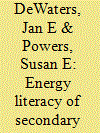|
|
|
Sort Order |
|
|
|
Items / Page
|
|
|
|
|
|
|
| Srl | Item |
| 1 |
ID:
103473


|
|
|
|
|
| Publication |
2011.
|
| Summary/Abstract |
Energy literacy, which encompasses broad content knowledge as well as affective and behavioral characteristics, will empower people to make appropriate energy-related choices and embrace changes in the way we harness and consume energy. Energy literacy was measured with a written questionnaire completed by 3708 secondary students in New York State, USA. Results indicate that students are concerned about energy problems (affective subscale mean 73% of the maximum attainable score), yet relatively low cognitive (42% correct) and behavioral (65% of the maximum) scores suggest that students may lack the knowledge and skills they need to effectively contribute toward solutions. High school (HS) students scored significantly better than middle school (MS) students on the cognitive subscale; gains were greatest on topics included in NY State educational standards, and less on topics related to "practical" energy knowledge such as ways to save energy. Despite knowledge gains, there was a significant drop in energy conservation behavior between the MS and HS students. Intercorrelations between groups of questions indicate energy-related behaviors are more strongly related to affect than to knowledge. These findings underscore the need for education that improves energy literacy by impacting student attitudes, values and behaviors, as well as broad content knowledge.
|
|
|
|
|
|
|
|
|
|
|
|
|
|
|
|
| 2 |
ID:
096099


|
|
|
|
|
| Publication |
2010.
|
| Summary/Abstract |
This research is aimed at monetizing the life cycle environmental and health externalities associated with production of ethanol from corn, corn stover, switchgrass, and forest residue. The results of this study reveal current average external costs for the production of 1 l of ethanol ranged from $0.07 for forest residue to $0.57 for ethanol production from corn. Among the various feedstocks, the external costs of PM10, NOX, and PM2.5 are among the greatest contributors to these costs. The combustion of fossil fuels in upstream fertilizer and energy production processes is the primary source of these emissions and their costs, especially for corn ethanol. The combined costs of emissions associated with the production and use of nitrogen fertilizer also contribute substantially to the net external costs. For cellulosic ethanol production, the combustion of waste lignin to generate heat and power helps to keep the external costs lower than corn ethanol. Credits both for the biogenic carbon combustion and displacement of grid electricity by exporting excess electricity substantially negate many of the emissions and external costs. External costs associated with greenhouse gas emissions were not significant. However, adding estimates of indirect GHG emissions from land use changes would nearly double corn ethanol cost estimates.
|
|
|
|
|
|
|
|
|
|
|
|
|
|
|
|
| 3 |
ID:
125432


|
|
|
|
|
| Publication |
2013.
|
| Summary/Abstract |
Many urban areas in the United States have experienced difficulty meeting the National Ambient Air Quality Standards (NAAQS), partially due to pollution from electricity generating units. We evaluated the potential for residential demand response to reduce pollutant emissions on days with above average pollutant emissions and a high potential for poor air quality. The study focused on New York City (NYC) due to non-attainment with NAAQS standards, large exposed populations, and the existing goal of reducing pollutant emissions. The baseline demand response scenario simulated a 1.8% average reduction in NYC peak demand on 49 days throughout the summer. Nitrogen oxide and particulate matter less than 2.5 µm in diameter emission reductions were predicted to occur (-70, -1.1 metric tons (MT) annually), although, these were not likely to be sufficient for NYC to meet the NAAQS. Air pollution mediated damages were predicted to decrease by $100,000-$300,000 annually. A sensitivity analysis predicted that substantially larger pollutant emission reductions would occur if electricity demand was shifted from daytime hours to nighttime hours, or the total consumption decreased. Policies which incentivize shifting electricity consumption away from periods of high human and environmental impacts should be implemented, including policies directed toward residential consumers.
|
|
|
|
|
|
|
|
|
|
|
|
|
|
|
|
|
|
|
|
|